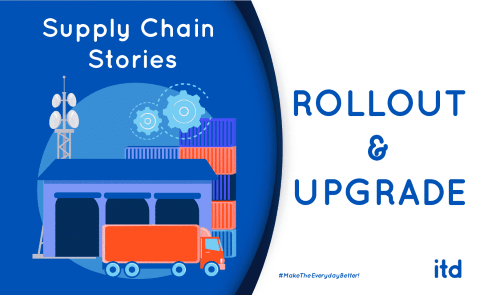
Supply Chain Stories ITD ClickOnSite upgrade rollout telecom
Deploying new sites, upgrading equipment to add 4G or 5G is a supply chain and planning challenge. Many processes must be implemented whether that be the requirements of the radio, to the installation, and through to the equipment commissioning.
It is important to find a location (for new sites), negotiate, define or upgrade programs, manage construction, and finally conduct a series of tests. The multitude of projects and the volume of sites to be simultaneously managed add complexity to some processes. Nevertheless, deployments must be managed efficiently within the constraints of deadlines.
Managing these operations is the main challenge. Also, locations for a single operation can be complex, separated either by hundreds of meters, or even thousands of kilometers across a country. It highlights the potential geographical constraints. Multiple players are responsible for their construction and installations, which adds difficulties to coordinate these critical phases. So, under these conditions, how can qualitative logistics be ensured from end-to-end? The goal is at a high level.
Florian Gayraud, Projects Director and supply chain expert at ITD, draws up his conclusions of the situation.
From the initial phase of purchasing and supplier negotiation, the characteristics of a challenging supply chain are met:
The main telecom equipment suppliers (Huawei, Nokia, Ericsson) control the market and technology. MNOs are dependent on their product catalog. They must clearly define their technical needs from this list. Once the radio or transmission plan is implemented, they can identify the equipment required for each program. This is the pre-order phase. However, even if it is unknown at this stage, the technical specifications of each installation can impact the Bill of Quantity.
The supply chain constraints and the commissioning planning of the installations must prioritize and sequence supplier flows. Obviously, the various components of storage strategies have a strong impact on the conditions of equipment provisioning. The equipment must be delivered – by road, air, or sea transport – within the country, in compliance with customs regulations. In this case, data management is essential to limit the temporary impact of the border crossing. Some regulations may require specific import mechanisms that multiply intermediaries or limit deliveries.
Now, the equipment delivered in the destination country has to be stored and then distributed according to programs and projects. There are many distribution stakes. What is the best method?
Whether, by the function of each warehouse, or their geographical distribution, the storage pattern on the territory directly impacts the structure and organization of suppliers’ deliveries.
The flows previously handled by each supplier must now respond to a multi-vendor and multi-equipment site logic. Stocks must meet the specific needs of each region. We are talking about a major storage and preparation phase with a strong impact on value creation. As these supply chain actions must be conducted alongside the site deployment progress, the control of each site’s specific information is essential. The time limits are too important to claim a linear process so the key is to ensure that the site design matches the information from the procurement process. It allows us to consider, with more guarantee, the supply of the correct products, in good quantity, and stored in the right place.
Finally, equipment must be distributed on each site at the appropriate time to allow its installation. This is the final challenge in the supply chain, which is always complex.
In conclusion, the supply chain stakes of deployment and/or upgrade operations are important. Although the operational financial risk related to a subcontracting failure is contained – turnkey contract, global lump sum payment for installation, – the financial impact of the coordination of physical and information flows remains. On the one hand, with the equipment cost to be installed (CAPEX), and, on the other, through the commercial cost of airing delays (loss of revenue). The logistics analysis and the implementation of supply chain management standards (processes, databases) are key performance drivers for combined deployment and upgrade operations.
Once the equipment is installed on-site, a new operational life cycle must be managed. Material and financial correspondence of the asset base, management of equipment allocations, and history, maintenance, and spare parts management are all part of the supply chain issues.